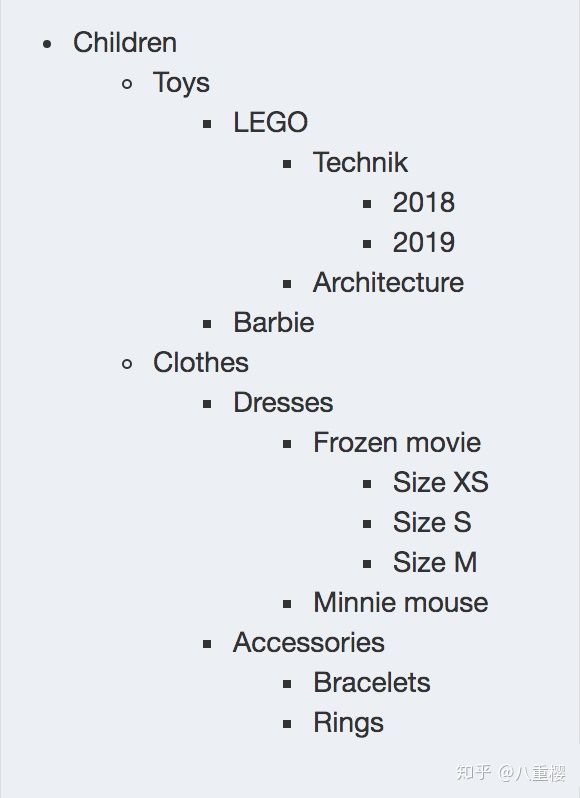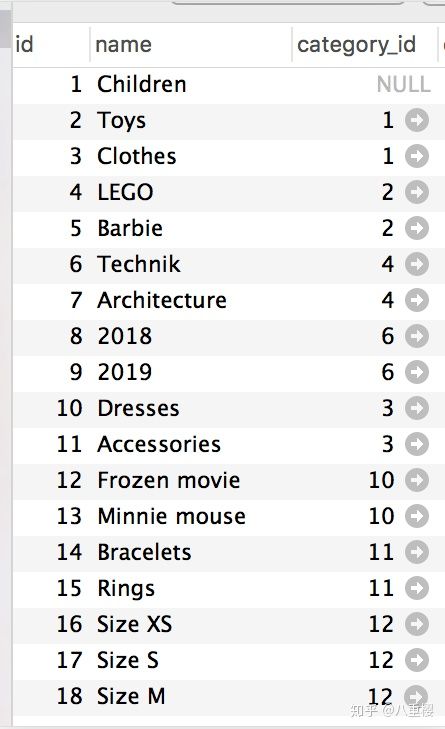In the online shopping mall, we can often see multi-level classification, sub classification and even unlimited classification. This article will show you how to implement it gracefully through Laravel Eloquent.
We will create a micro project to show the classification of children's shops, with 5 levels in total, as follows:

Database migration
Simple data table structure:
Schema::create('categories', function (Blueprint $table) {
$table->bigIncrements('id');
$table->string('name');
$table->unsignedBigInteger('category_id')->nullable();
$table->foreign('category_id')->references('id')->on('categories');
$table->timestamps();
});There is only one name field associated with itself. Therefore, most of the parent categories have a parent id = null
The data in the data table are as follows:

Eloquent model and correlation
First, create a simple hasMany() method in app/Category.php. The classification may have its own classification:
class Category extends Model
{
public function categories()
{
return $this->hasMany(Category::class);
}
}
The best "strategy" in the beginning of a good play. Did you know that recursive relationships can be described like this? As follows:
public function childrenCategories()
{
return $this->hasMany(Category::class)->with('categories');
}
Therefore, if you call Category::with('categories'), you will get lower level "subcategories", but you can achieve unlimited through Category::with('childrenCategories').
Routing and controller methods
Now, let's try to show all categories and subcategories, as shown in the example above.
In routes/web.php, we add the following:
Route::get('categories', 'CategoryController@index');
app/Http/CategoryController.php is as follows:
public function index()
{
$categories = Category::whereNull('category_id')
->with('childrenCategories')
->get();
return view('categories', compact('categories'));
}
We load only the parent category, with the child category as the relationship. Easy, right?
Views and recursive subviews
Finally, render to the page. In the resources/views/categories.blade.php file:
<ul>
@foreach ($categories as $category)
<li>{{ $category->name }}</li>
<ul>
@foreach ($category->childrenCategories as $childCategory)
@include('child_category', ['child_category' => $childCategory])
@endforeach
</ul>
@endforeach
</ul>
We first traverse the top-level parent category, then traverse the child categories of the parent category, and then use @ include to load the child categories of the child categories
The best part is that resources/views/admin/child_category.blade.php will use recursion to load itself. See code:
<li>{{ $child_category->name }}</li>
@if ($child_category->categories)
<ul>
@foreach ($child_category->categories as $childCategory)
@include('child_category', ['child_category' => $childCategory])
@endforeach
</ul>
@endif
In child category.blade.php, we include @ include('child category '), so as long as there are categories in the current subcategory, the template will recursively load subcategories.
this is it! We have infinite levels of subcategories - whether in databases, relationships, or views
For more information, please visit:
